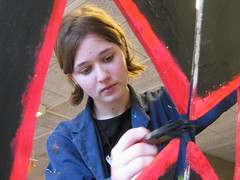
This girl is working in my classroom. She is as concentrated as not even to be disturbed by the photographer.
Apparently the assignment I gave her compelled her to do a good job. The result fulfilled the demands included in the task given to the class. It had to do with expressive quality in art by exaggerating form aspects.
I introduced this task with the question why art can be appreciated across cultures and referred to the idea of "Peak Shift," introduced by V.S. Ramachandran
So I guess she learned something about that. I can not be sure because the scope of the course didn't allow an extensive test.
Her gusto may have been triggered by the sheer size of the work, which exceeded anything she had worked on before.
A wonderful book
I am reading a book by
Daniel T. Willingham these days:
"Why Don't Students Like School?". The content is very satisfying for a teacher. In Dutch education teachers have been harassed by ideologists of every ilk since 1993 when the government implemented a major change in secondary education. Willingham is a cognitive psychologist. His book debunks a great deal of the myths that underlie deprecating views on proven teachers' routines. Recommending this book does not mean I want to fuel those colleagues who are unwilling to reflect critically on their daily work with children. It goes without saying that teachers have to adapt continuously to ever-changing demands of society. Nevertheless, the book keeps me smiling while turning pages because it confirms that a lot of ideas about learning are not supported by science at all and some are falsified by research.
I consider my classroom to be a laboratory in which the teacher's hypotheses are tested against children's motivation and visible results of learning. Remember I teach art. Nice products do not guarantee effective learning, but poor products show clearly that something went pearshaped. Enthused children are not necessarily proof of good teaching, boredom is evidence of the converse.
The gap between theory and practice
Background reading is indispensable for a teacher. The try-and-error in the classroom must be subsumed into intelligent thought of others. Often I have experienced a gap between literature and my everyday experience. Neither did
Skinner's pigeons resemble my students, nor did
Marxist education in visual communication appeal to them.
Constructivistic ideas seeped into my work with meagre results. So mostly I resort to common sense based on over thirty years of experience. Only recently does theory bridge the gap. Willingham's book is wonderful. But there is not very much on Art Education in it and I have some objections. I will get back to that a.s.a.p





No comments:
Post a Comment